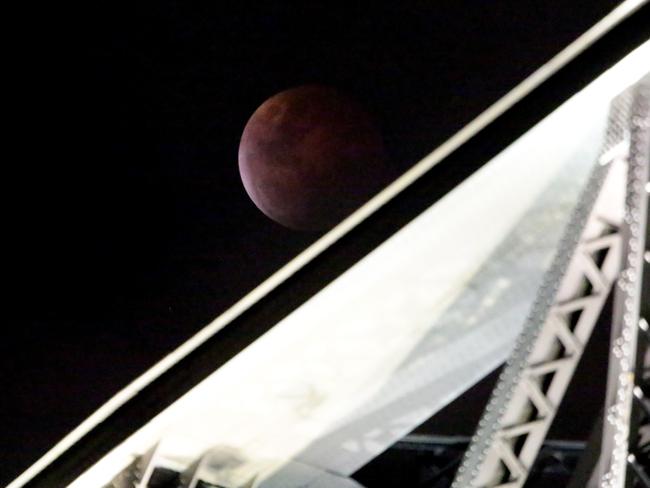Lunar eclipse leaves stargazers with a red Blood Moon
STARGAZERS in Australia and around the globe have watched a lunar eclipse bathe the moon in red to create a “Blood Moon”.
STARGAZERS in the Americas, Australia and Asia have witnessed a lunar eclipse, a celestial show that has bathed the moon in red to create a “Blood Moon.”
Evening viewers in much of Asia and early risers in parts of the Americas were treated to a stunning lunar eclipse, though clouds obscured it for some.
Lucky ones saw the moon turn orange or red in what is known as a “blood moon.”
The striking colour results from sunlight scattering off Earth’s atmosphere.

On Australia’s east coast, cloud cover was seen less than an hour ahead of the Moon’s move into Earth’s shadow.
Whoops of joy erupted at the Sydney Observatory in Australia as the moon made a brief appearance.
“Very spectacular,” observatory astronomer Geoff Wyatt said.
“The cloud certainly got in the way, but we’ve seen it during totality and of course that’s always the highlight — to see that lovely, reddish-brown colour.”

MORE PICTURES FROM AROUND AUSTRALIA AND THE WORLD BELOW
In Canberra, Rachel Buckley watched from her driveway.
“It looked small, but very, very clear and really orange, I thought — blood orange,” she said.
“It was quite exciting, pretty amazing to see. because it’s not very often you get to see that.”
Photographs of the Moon from all over the country started to emerge as the eclipse got underway.
In Japan, clear skies turned partly cloudy as the eclipse progressed, but some people who gathered on the rooftops of skyscrapers in Tokyo saw the moon turn a rusty brown when the clouds cleared.
“When the sun, moon and earth align, I get the feeling that we are also a part of the solar system,” Yoshiko Yoneyama, a 66-year-old homemaker, said. “It’s that kind of feeling.”







#BloodMoon2014 #LunarEclipse from Perth, Western Australia at 7:13pm on 8th October 2014 pic.twitter.com/DuRfgsXMHW
— Pamela Chng (@pamchng) October 8, 2014
Clouds cleared for 30 secs to give this great glimpse of the #BloodMoon #LunarEclipse over #Sydney by @John__Donegan pic.twitter.com/k7EJSxaYsJ
— 702 ABC Sydney (@702sydney) October 8, 2014and a steadier shot just before the clouds took over (Queensland, Australia) #LunarEclipse pic.twitter.com/ICqPXm7jhh
— Fiona McMillan (@fmmcmillan) October 8, 2014Here's a photograph of the #lunareclipse happening right now in South Australia. pic.twitter.com/G3jL64lHZ7
— Clint Burkinshaw (@ClintBurkinshaw) October 8, 2014
#LunarEclipse from Newcastle, Australia via @Slooh pic.twitter.com/QhXBIhVsjF
— Steve Grzanich (@SteveGrzanich) October 8, 2014WATCH THE LIVE STREAM AGAIN BELOW
The early phase of the eclipse began 4.00am, on the east coast of the United States.
NASA provided live footage via telescope of the eclipse, showing a black shadow creeping across the moon in a crawl that took about an hour.
Only when the moon was totally eclipsed did the redness appear. The total eclipse was also to last about an hour, and ditto for the return to its normal colour. The total eclipse happened at 6:25am on the US east coast (1025 GMT).
The NASA web site was peppered with Tweets bubbling with questions and comments on the heavenly phenomenon.
“This is amazing. Thank you for this opportunity,” read a Tweet from the handle @The Gravity Dive.
“Is there any crime increase during this process? Any psychological problems?” wrote a person who identified herself as Alisa Young.
Just before the climax, Kathi Hennesey in California wrote, “Watching from San Francisco Bay Area. Just a sliver now.”

PICTURES: LUNAR ECLIPSE AROUND THE WORLD
PICTURES: How Western Australia saw the Moon
PICTURES: South Australia watched the Moon turn red
— Ring of fire —
A NASA commentator explained that during the total eclipse, if you were standing on the moon and looking at the earth, you would see it all black, with ring of fire around it.
In Hong Kong, free viewing locations were set up on a harbourside promenade by the Hong Kong Space Museum for the public to observe the various phases on telescopes.
In Tokyo’s Roppongi fashion and entertainment district, enthusiasts performed yoga exercises under the blood moon. Many others had climbed atop the city’s skyscrapers to view the sky.


#BloodMoon! Red & orange light scattered by the atmosphere. Watch: http://t.co/JAuaXWK4JD #LunarEclipse #eclipse pic.twitter.com/evVd0yUN9B
— NASA (@NASA) October 8, 2014The moon outside is nothing but a SLIVER in the sky! Check out live shots from @NASA on #GDC #BloodMoon #Eclipse pic.twitter.com/0DR3o6SM05
— WSYX ABC 6 (@wsyx6) October 8, 20146:35 Moon over DC. @wusa9 @Toppersweather @ericagrow @capitalweather @CBSThisMorning @SkyGuyinVA @MarkVogan @wnew pic.twitter.com/jb4OtOXnG6
— Howard Bernstein (@hbwx) October 8, 2014In Hong Kong, hundreds of patient onlookers of all ages lined the harborfront promenade late Wednesday hoping for a glimpse of the eclipse.
Many came armed with cameras and telescopes but on a cloudy evening in a city whose sky is rarely clear of pollution haze, it was visible only intermittently.
With tweets from across the viewing countries in Asia, one in New Zealand described the eclipse as “omg the sky is red right now ... at 12:26am in Auckland” with the hashtag “#sofreakingcoool. ”

The event was not visible in Africa or Europe, NASA said.
The eclipse is the second of four total lunar eclipses, which started with a first “blood moon” on April 15, in a series astronomers call a tetrad.
The next two total lunar eclipses will be on April 4 and September 28 of next year.
The last time a tetrad took place was in 2003-2004, with the next predicted for 2032-2033. In total, the 21st century will see eight tetrads






